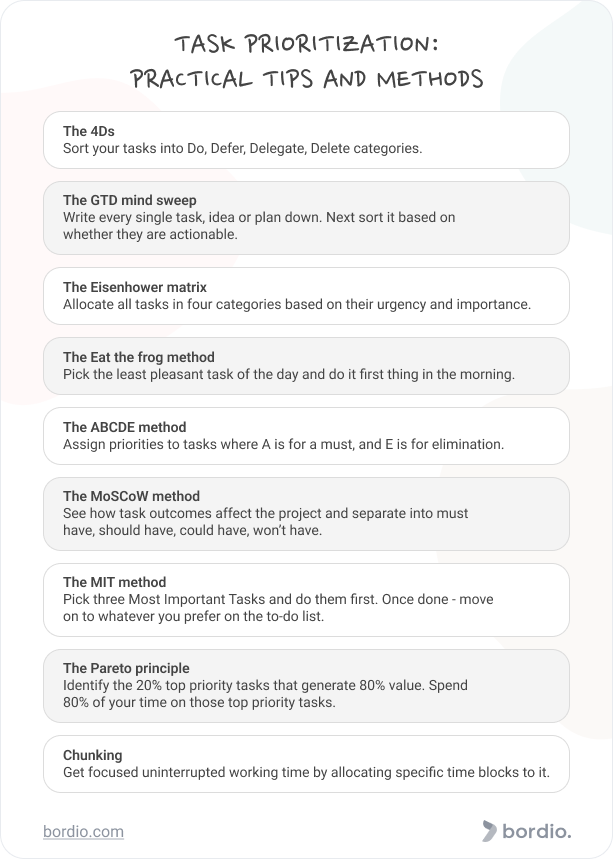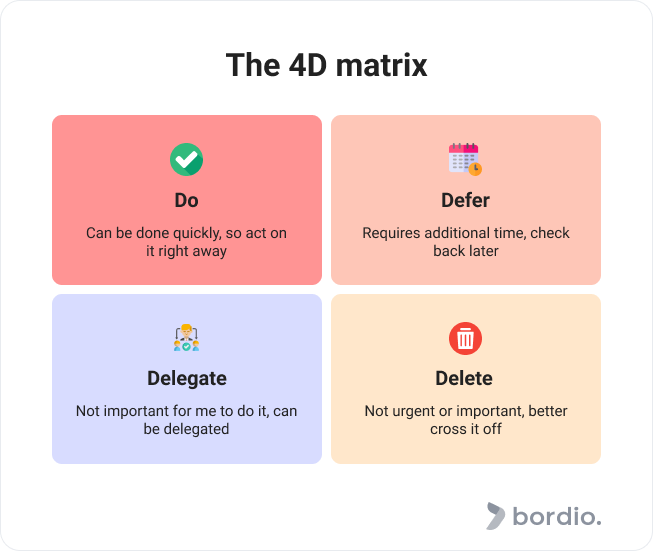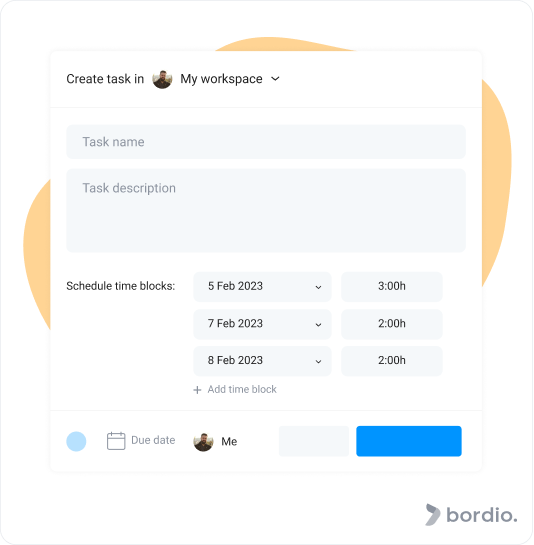We’ve all been in a situation where we are being crushed with incoming tasks from one side, while our backlog is slowly piling up on the other side. When that happens, we often decide to get our online to-do lists in a daily task tracker back under control and sort them out.
That’s when we go through our commitments and find out that all of them are high-priority tasks. And while it can be frustrating and demotivating, it’s not the end of the world.
Even if every single task appears to be an urgent matter, it rarely is. And in today’s article, we will show you that any to-do list and schedule creator can be dropped down according to priority, and we will share good techniques and recommendations that will make you a task prioritization champion.
Why is prioritizing tasks an important thing to do?
Many people live their lives without worrying about prioritizing tasks in their daily planners. So why should you?
When you go with the flow and ignore planning in schedule calendar planner or prioritizing, you often feel that:
- You are constantly playing catch-up
- You risk missing deadlines
- You are failing at your goals
- You are always stressed and overwhelmed
- Your productivity is low
- Your time is wasted
As you see, not paying attention to all your tasks can backfire in many different ways, so it’s best to avoid a catastrophe by prioritizing tasks and working through them before they start dictating your life.
Where to start with prioritizing tasks? Prep work
If you’re not used to working with your to-dos, then you might struggle with finding a starting point. But worry not – we are here to help!
Step 1: create a single task list
Find all your digital and paper notes, check the digital calendar planner, and look in the mailbox – make sure to go through all places where you sometimes leave tasks for the future self.
It’s important to find them all and put them in a single master list where you will be able to see your entire workload. We recommend having both personal and work tasks on the list for best results. The two different aspects of our lives are very interconnected and co-dependent, so if you want to maximize the benefits of the exercise, separating the two worlds will be an obstacle.
Pro tip 1: Take a brief look at your master list – are there any to-dos that you already see that can be crossed off? Something that’s not that relevant anymore, or a task that’s associated with something that you are no longer interested in but was afraid to admit to yourself. Maybe some of them can be delegated? Especially if they’ve been pushed back a few times already.
Pro tip 2: Utilize project management tools that will automate and simplify the process for you. Bordio’s free week planner, for example, allows you to have an active to-do list but also a waiting list for tasks without a specific due date or the tasks that can be pushed back without creating any risks or damage. Simple virtual planner by bordio is very handy for such sorting. The waiting list is conveniently placed to the right of your main schedule or to-do list, so you can always add or move items back and forth as you look through your weekly tasks.
Step 2: add information to your tasks
Congratulations! All of your tasks are in one place now, and that’s already a big step towards success.
Now it is time to do a bit of work with your master list. Go through it in your time management tool for work and see if you can specify:
- The deadline – formal or your preferred one
- Amount of time the task takes to complete
- Level of urgency (for example, not urgent, rather urgent, very urgent)
- Co-dependencies with other tasks on the list
By the way, Bordio’s best task organizer allows you to visualize task priorities with colors, making your prioritized task list even easier to work with.
It’s okay if you won’t have some information for each of the tasks, but the more understanding you gather at this point, the easier it will be for you moving forward. The ultimate goal here is to set you up for success through clarity and organization by providing a single view of your workload and giving you rough estimations of how much time they’ll take and how difficult that would be.
With that understanding in mind, you are ready to move on to the actual process of prioritizing your tasks.
Pro tip: If you have tasks with specific due dates and rough estimations of how much time they will take, you can schedule them in your Bordio calendar. Add time blocks to secure the time to work on them.
For example, you need to write a project implementation plan for next Friday that takes 5 hours. Create a task with a deadline and place it in the calendar. Then you can set three separate time blocks (2 hours, 2 hours, and 1 hour) and spread them across a few days to make sure you have the time to finish your plan.
It’s a simple and genius way to avoid situations where you get a notification that the task must be submitted in 2 hours but you’ve completely forgotten about it and haven’t even started yet.
Task prioritization techniques everyone should know
One of the secrets of integrating the process of prioritizing tasks into your life once and for all is to find a method that suits you best and utilize it.
There are many prioritization strategies, methods, and instruments out there that you can use to manage tasks. However, a lot of those techniques are based on the good-old classics which we will share with you now.
By the way, it’s perfectly fine to mix and match, and to move from one technique to another if you feel like it. Whatever helps you stay on track and organized is good.
#1 The 4Ds (do, defer, delegate, delete)
The 4D matrix is more like a time management tool, but it can be a prioritization method as well. Perhaps you’re better off starting with the 4D model and complementing it with some other techniques that we are describing later in the article.
The matrix tells us to categorize tasks across four categories: Do, Defer, Delegate, and Delete. Once the workload is allocated, you can instantly see important tasks and dedicate your most productive hours to them.
#2 The GTD mind sweep
The GTD mind sweep was created by David Allen and summed up in the legendary Getting Things Done book. We did a separate article on the mind sweep where we dig deeper into the method.
In short, you can use mind sweep for listing all to-dos and prioritizing them later or just for prioritizing tasks. First, you do a brain dump session where you list absolutely everything. It can be an important task or something like throwing out your old socks. Basically, everything that clutters your mind needs to be listed. You then transform all those to-dos and ideas into tasks. The next step is to identify if these tasks are actionable or not, and either go ahead and schedule them right away or push them for the time being.
You can read more about the Getting Things Done hit by Allen and other great books in our best productivity books list.
#3 The Eisenhower matrix
The Eisenhower matrix is extremely popular for prioritizing tasks.
We take all the tasks and organize them into four quadrants based on the tasks’ urgency and importance. Once you do that, it becomes very easy to see what is truly important.
#4 The Eat the Frog method
Eat the frog method was popularized by Brian Tracey, and it is pretty simple when you think about it.
The method tells us to find the most annoying and least exciting thing to do and just go for it. We often have difficult tasks that we don’t even want to think about. So instead, we postpone them again and again, but keep thinking about them, and it ruins our vibe for the entire day.
Tracey says that it’s counterproductive and recommends “eating the frog” first thing in the morning. That will make you fulfilled right away and give you a huge boost for the rest of the day.
By the way, we talk more about Brian Tracey’s and many other great time management books in our dedicated books article, so make sure you check it out for inspiration and tons of great recommendations.
#5 The ABCDE method
With the ABCDE method, you assign letters to your tasks according to their importance and urgency, where A is an absolute must-do, and E is for eliminating.
This method gives us more layers of urgency and importance than the Eisenhower matrix. And it works especially great for people with loads of different tasks, as opposed to someone who deals with similar assignments most of the time.
As and Bs require your immediate attention, and the lower priority level tasks (C, D, E) can be dealt with later or delegated.
#6 The MoSCoW method
This Russian capital-inspired method stands out as it encourages us to prioritize tasks based on their outcomes. It is an excellent project management tool for stakeholders and project managers to see the tasks’ importance for the project’s delivery.
The method divides to-dos in time planner calendar by:
- Must have – if it’s not done, the project is failed.
- Should have – not project-killer if failed but important to do.
- Could have – can be delivered if remaining resources allow.
- Won’t have – an outcome won’t be delivered as a part of the project.
#7 The MIT method
This next method was introduced by Leo Babauta, the author of Zen Habits.
MIT stands for Most Important Tasks.
As Leo recommends, we choose up to three tasks that hold true importance and do them during the day. Once the top-3 are done, and if there is still time left, we move on to other daily tasks. At this point, we select whatever we feel like doing, and it’s okay if they’re not the most critical ones.
#8 The Pareto principle
The Pareto principle, a.k.a. the 80/20 rule, was introduced by Vilfredo Pareto.
There are two ways we can think about the principle in terms of prioritizing tasks:
- 20% of our tasks generate 80% value, so we need to identify the key 20% and focus on them.
- 80% of our time should be spent on tasks that generate the most outcomes, and 20% can be dedicated to the rest.
#9 Chunking
Chunking is also known as time boxing, and it is a 2-in-1 technique because it helps you prioritize tasks AND it enhances your time management.
With chunking, you are creating focused time blocks where you mustn’t be interrupted for anything else. A time block can be assigned to a complete task (edit the video), part of the bigger task (complete paperwork for an upcoming investment round), or you can group similar tasks together for most efficiency (like a reply to all emails).
By the way, we at Bordio love chunking! One of our favorite tools is time blocking. When creating a task, you can add time blocks and spread them evenly on your schedule to ensure you have sufficient time to do the job. You can’t complete the task unless all time blocks are ticked off.
Post task prioritization: review, revise, repeat
You are rarely in a situation where nothing changes. It’s almost impossible today not to have a single thing added, removed, or changed from your to-do list once you’ve created it.
So, to remain productive and up to date, you should go back to your task lists regularly and review them. Should any adjustments be necessary, apply them to the list and see how that affects the priorities you’ve set before.
As you start prioritizing tasks, don’t forget about other productivity habits. Get started with our productivity tips everyone needs to adopt guide and a list of recommendations to be productive at home, whether you work or rest. It is also helpful to learn to manage your time more effectively, so if you’re up for it – have a look at our critical time management skills piece.
More tips for better task prioritization
Here are some more recommendations to help you prioritize tasks like an absolute pro.
#1 Write everything down
Any task – big or small – should be written down. It’s great if you have a good memory but nobody can remember everything all the time. Plus why would you torture your brain like that?
Once written down, you won’t forget about it but you will also release yourself from having to keep it in the back of your mind at all times.
Did you know that Bordio has a mobile app, so you can always add tasks to your list wherever you are? Standing in line in the pub, walking your dog in the park, or watching your favorite TV show.
#2 Avoid priority competition
It’s okay if you have a few easy tasks that you can work on simultaneously.
But as we are trying to focus on top priority critical tasks first, these are the types of to-dos that are best handled when worked on exclusively. Multitasking leads to worse results across all the work you are trying to do at once. Staying focused on one priority at a time, in turn, will reduce the time it takes you to complete the job, and you make fewer errors.
#3 Break down large goals
Always break down large goals into smaller bits that are easier to manage. Smaller tasks seem more realistic to tackle in one sitting. And one of the key reasons we procrastinate and postpone doing something is because the job just seems too grand.
#4 Think and plan long-term
Long-term planning allows us to consider upcoming goals and tasks when we plan for the next week or month.
If you know about future complex tasks in advance, you can incorporate them into your schedule better. That means they are more likely to be achieved with the best results and within deadlines. For example, you may have a slow period where your monthly tasks are not too demanding, so you choose to relax a little. Yet, if you know that in about two months several important projects will be launched, you might consider doing some extra work now when you have free time and a laid-back schedule.
#5 Differentiate between urgent and important
We must remember that urgent and important tasks are not the same.
They both seek our attention and pop up at the top of our priority list. As you are looking to find time for both, double-check that you are not only dealing with urgent but unimportant tasks.
For example, you can dedicate 2 hours each day to urgent tasks, and then the rest should be allocated for important work. The less pressing jobs should either be handled in the leftover time, delegated, or eliminated.
#6 Be realistic
It’s unlikely that you will be able to complete all the tasks on your to-do list during the time that you have mentally allocated for it. Don’t set yourself up for failure. Be realistic and flexible.
Some people say that you should not have more than six tasks assigned per day, and only 2-3 of those tasks can be urgent and important. Listen to your inner voice when it comes to creating your own task list, but remember that you are not winning anything by being the busiest or the most overwhelmed.
Final thoughts on task prioritization
Prioritized work translates to productive work.
Planning and organizing your to-do list will save lots of time and stress in the future. You will be better prepared and less likely to procrastinate. Having structure will avoid workload fatigue where you are too overwhelmed with what must be done even to try and tackle it. In addition, we also recommend trying the handy electronic planner app and task maker app.
Don’t wait for when the situation becomes so critical that you have no other choice but to work through the task list and prioritize your work. Start today and enjoy meeting deadlines, better time and resource use, and an optimized workload for you and your team.











